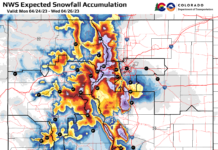I-70 MOUNTAIN CORRIDOR and SW MOUNTAINS TRAVEL ADVISORY ―
Snowy Conditions Expected on Saturday
High Country Travelers Urged: Be Prepared & Be Equipped
STATEWIDE ― The Colorado Department of Transportation (CDOT) encourages those heading into the high country this weekend to be prepared for heavy volumes of traffic and be equipped for snowy weather.
“This is the final week of winter break before students head back to school. We are expecting that last surge of holiday traffic with folks trying to take advantage of the new snow that’s forecast for Saturday,” said CDOT’s I-70 Mountain Corridor Manager Patrick Chavez. “We’ll certainly see heavy and slower traffic at the typical hours of the day — in the morning when folks are headed into the mountains and in the evening when they are headed home.”
Chavez continued, “We really encourage travelers to be prepared for the changing road conditions. Our patrols are getting plows ready for the weekend, to clear the roads of snow and keep the traveling public moving safely. But the best strategy during adverse weather is for travelers to slow down and keep a safe distance between you and the car in front of you.”
FORECASTED CONDITIONS: The National Weather Service (NWS) has issued a winter weather advisory for much of the I-70 corridor, Central Mountains, Northwest San Juan Mountains and Southwest San Juan Mountains. Snow is expected to start falling around noon on Saturday with the storm continuing through Sunday morning. Because snow accumulations could reach five to ten inches at higher elevations along I-70, motorists are reminded to be prepared for the possibility of safety closures. Safety closures are conducted when road conditions become unsafe. The closures allow time for patrols to work efficiently and return the highway to a safe condition for travelers.
WINTER DRIVING TIPS:
Check your tires
Worn tires can’t grip the road well and can be extremely hazardous. Check your tires by performing the Quarter Test. Insert a quarter into the tire tread upside down, with Washington’s head going in first; if the top of George’s head is covered by the tread, your tires are OK (do this test in multiple points around each tire). If the top of his head is visible at any point, you need new tires.
Invest in safety by getting a set of snow tires. When it comes to stopping safely on snow and ice, all-season tires simply don’t compare to winter tires (see infographic).
If your tires don’t have at least a one-eighth inch tread when a Traction Law is called, you are in violation of the law and could end up with a fine.
Leave extra room
Leave extra room between your vehicle and others on the road at all times.
Even vehicles with four-wheel/all-wheel drive will not stop any quicker on icy roads, especially if you have inadequate tires.
Drive for conditions
Slow down! In poor visibility, don’t drive faster than you can see ahead. High speeds in poor visibility can lead to vehicle crashes.
Give yourself plenty of space! Keep a safe distance between you and the car in front of you. Vehicles traveling too close can lead to crashes and dangerous chain reactions.
Bow to the plow
Snow plows need space to work, so unless you want to cause a crash, delays or be stuck on a snow-covered road, don’t crowd the plow!
If you must pass a snowplow, do so on the left and with extreme caution.
Be I-70 smart
Check Goi70.com to see travel forecasts for the I-70 mountain corridor, road updates, rideshare and parking information, deals on lodging, food and entertainment for travelers and more.
Remember to avoid peak travel times whenever possible and consider carpooling or alternative transportation.
Have a plan
If you are stuck in a serious storm, do not leave your car. Run the engine periodically and wait for help.
Prepare a winter driving vehicle kit. Carry blankets, water, a flashlight, a shovel, some nutrition bars or other food for sustenance. Winterize your vehicle’s safety kit by including extra blankets, sand to help gain traction in the event you become stuck on ice or snow, jumper cables and an ice scraper.
KNOW BEFORE YOU GO: CDOT has broad authority to close any portion of a state highway to traffic due to a natural disaster, weather conditions, or any other emergency circumstances resulting in making road conditions unsafe for travel by motor vehicles. That authority includes closing a road to traffic if adequate tire chains or snow tires are determined to be necessary.
AVOID A FINE! Motorists should be aware the Traction Law (Code 15) and Passenger Vehicle Chain Law (Code 16) could be implemented if conditions require it. When either law is in effect, highway signage will be activated. Without proper equipment, you can be fined $130. If your vehicle blocks the roadway, you could be fined more than $650.
Traction Law — Motorists will need snow tires, tires with mud/snow (M/S) designation, or a four-wheel drive vehicle — all tires must have a minimum one-eighth inch tread.
Passenger Vehicle Chain Law — Every vehicle on the roadway must have chains or an alternative traction device (like AutoSock).
SNOW PLOW TRACKER: The public can view snow plow locations on any device by clicking https://cotrip.org/snowplow.htm#/snowplow (also see upper right hand corner of cotrip.org menu). Using this information, motorists will be able to see plows’ current locations, their travel speed and direction they are traveling. Plows that have not moved for more than 16 minutes will not be visible.
STAY INFORMED:
Sign up for project or travel alerts: bit.ly/COalerts
See scheduled lane closures: codot.gov/travel/scheduled-lane-closures.html
Connect with us on Twitter (@coloradodot) and Facebook (facebook.com/coloradodot)









